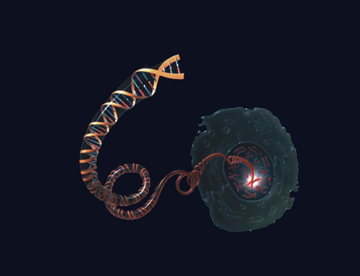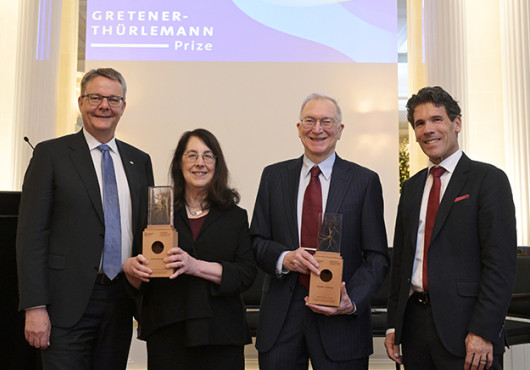
A DNA molecule unwinds from a chromosome inside the nucleus of a cell. Image: National Human Genome Research Institute
A next-generation genome-editing system developed by Harvard Medical School investigators at Massachusetts General Hospital substantially decreases the risk of producing unwanted, off-target gene mutations. In a paper published in Nature Biotechnology, the researchers report a new CRISPR-based RNA-guided nuclease technology that uses two guide RNAs, significantly reducing the chance of cutting through DNA strands at mismatched sites.
“This system combines the ease of use of the widely adopted CRISPR/Cas system with a dimerization-dependent nuclease activity that confers higher specificity of action,” said J. Keith Joung, HMS associate professor of pathology at Mass General and senior author of the report. “Higher specificity will be essential for any future clinical use of these nucleases, and the new class of proteins we describe could provide an important option for therapeutic genome editing.”
Engineered CRISPR-Cas nucleases are genome-editing tools that combine a short RNA segment matching its DNA target with a DNA-cutting enzyme called Cas9. The tools have been the subject of much investigation since their initial development in 2012. Easier to use than the earlier zinc finger nuclease (ZFN) and transcription activator-like effector nuclease (TALEN) systems, they have successfully induced genomic changes in several animal model systems and in human cells. But in a previous Nature Biotechnology paper published in June 2013, Joung’s team reported that CRISPR-Cas nucleases could produce additional mutations in human cells, even at sites that differed from the DNA target by as much as five nucleotides (the subunits of DNA).
To address this situation, the investigators developed a new platform in which the targeting function of Cas9 was fused to a nuclease derived from a well-characterized enzyme called Fokl, which functions only when two copies of the molecule are paired, in a relationship called dimerization. This change essentially doubled the length of DNA that must be recognized for cleavage by these new CRISPR RNA-guided Fokl nucleases, significantly increasing the precision of genome editing in human cells. Joung and his colleagues also demonstrated that these new RNA-guided Fokl nucleases are as effective at on-target modification as existing Cas9 nucleases that target a shorter DNA sequence.
“By doubling the length of the recognized DNA sequence, we have developed a new class of genome-editing tools with substantially improved fidelity compared with existing wild-type Cas9 nucleases and nickases,” the enzymes that cleave a single DNA strand, said Joung, who is associate chief for research in the Mass General Department of Pathology.
The research team also has developed software that enables users to identify potential target sites for these new RNA-guided Fokl nucleases. The freely available software package is ZiFiT Targeter.
The study was supported by National Institutes of Health Director’s Pioneer Award DP1 GM105378; NIH grants R01 GM088040, P50 HG005550 and R01 AR063070; and the Jim and Ann Orr Massachusetts General Hospital Research Scholar Award. Joung is a co-founder of Editas Medicine Inc., which has an exclusive option to license the new CRISPR RNA-guided Fokl nuclease technology for therapeutic applications.
Adapted from a Mass General news release.


